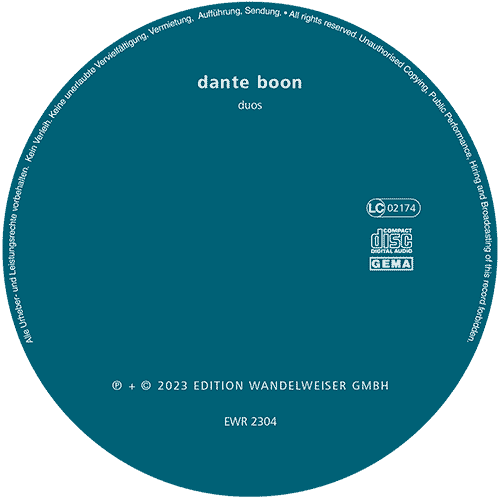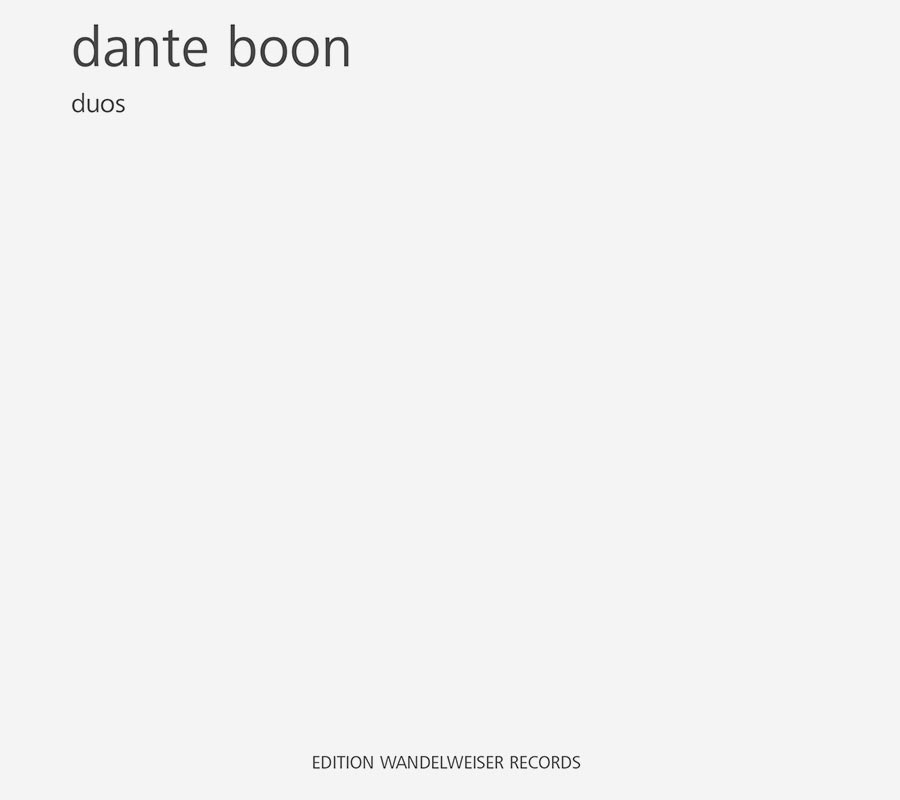EDITION WANDELWEISER RECORDS
> CD catalogue
>> dante boon
_____________________________________________________________________
<< >>
duos
dante boon
| order
reference: medium: composer: performer: |
EWR
2304 CD dante boon antoine beuger (whistling), dante boon (toy piano, various objects, voice, piano), sasha elina (voice), rene holtkamp (guitar), marianne schuppe (voice, piano), sytske van der ster (various objects, voice) |
| |
|

|
 |
dante boon duos 01 ruht nicht aus (2015) 02 lied (je slaapt) (2012) 03 duo (guitar) (2018) 04 duo: table & books (2020) 05 20 / 21 (2021) 06 alone (2021) performed by (amongst others): antoine beuger (whistling) (5), dante boon (toy piano, various objects, voice, piano) (2, 4, 5), sasha elina (voice) (6), rene holtkamp (guitar) (3), marianne schuppe (voice, piano) (1), sytske van der ster (various objects, voice) (4) audio excerpt: ► lied (je slaapt) (15:16) ► 20/21 (09:10) A manner of counting together: this could be one definition of meter. Counting together so as to be “in the same time”. Even when making music solo, you’ll be together in this sense, if only with some projected listener, or with yourself. Meter is not just measuring time, as it was in a lot of advanced music from the past century that featured complex time signa- tures or polymetrical techniques. Complementary to this, meter is also variable intensity and plasticity of time. Getting a tango, a waltz or a mazurka right – how a downbeat is different from an upbeat, how each meter will have its own little lilt, its inner shifts that make counting together live. The most fundamental platform for meter is the duo. In a duo, counting time really is a relation to one literal other. A minimal codependency. Two people providing one another with the space to shape temporal intensities. In the pieces of this disc, Dante Boon shows himself to be a deep thinker about meter among composers working today, as part of the tradition of John Cage – specifically of Two2, a duo for pianists in which Cage was influenced by Sofia Gubaidulina’s remark that “there is an inner clock”. In that piece, two pianists play chords freely but still depend on each other’s decisions for the timing of every unit, instead of depending on a stopwatch as in most of Cage’s Number Pieces. To that tradition of free interdependence, Dante adds a sensibility from more traditional music, of embodied counting and stress, nuanced patterned intensities, meter as life form. The pieces on this disc all feature expanded notions of counting and togetherness. Players can be “in the same time” even when not being measurably synchronized. Rather, the same time is an emergent composite of two individual, non-identical, but inter- related counting processes. You could say, an unmeasurable synchronization. Remarkably, many of these duos are notated on a single staff. One notation, interpreted differently by each of the two players. In Lied (je slaapt) for instance, two players play the same measures, but counting them differently: for every measure, the (toy) pianist choosing to use four, six or eight counts per note, and the clarinetist choosing five, seven or nine. The result is a togetherness that can never synchronize strictly. Instead, bar by bar, spontaneous tempo canons result. This openness of time even bleeds into the form itself – the piece has five sections like a rondo, with the two instruments starting every measure together in the odd sections. In the second section, however, the pianist enters later, in the fourth one, the clarinetist enters later. But the score does not indicate where the next section will begin; that, too, is up to spontaneous player decisions. The result is a freely shifting mosaic of varied togethernesses. In Duo: table & books performers similarly decide section boundaries. For example, the first part of the piece begins with two sounds from performer I always alternating with one sound from performer II. Halfway through, however, performer II will decide to invert these roles by making a sound following the first sound of performer I – and then following with a second sound. From that moment, it will always be two sounds from performer II alternating with one from performer I. So there is a two-one “meter”, but as the roles shift, the intensities are redistributed as a subtle variation in metrical personality. This is a “meter” for a specific situation – two people, sitting at a table, each reading their own book. At first they make sounds while reading that are “non-intentional in nature” as the score says, later they read single words from their books out loud, creating fleeting verbal encounters between two different inner worlds. On this disc, ruht nicht aus and Duo (guitar) are two mirroring commentaries on duo-ness. The guitar piece is a duo, but for a single player. Here, the main section actually is on two conventional staves linked by barlines. However, the guitarist is to play the top and the bottom voices freely, as if two interdependent players in the manner of Two2. Other sections are interwoven into this, involving other forms of polyphony: dyads, or laisser vibrer tones overlapping with new attacks. The result is an ambiguous listening experience, generally sounding like a single compound melody but always also suggesting two underlying streams. Conversely, ruht nicht aus for voice and instrument – here also performed by a single performer – notates the two voices only as dyads that are to be played strictly together – though of course, the beginning and ending of a note means some- thing quite different for a voice or a piano. Yet the two need to negotiate what “together” means for such different sounds. In both these performances on this disc, a single interpreter splits themself up and must negotiate time with this inner other. Are we hearing one voice, two voices, or some spectral in-between? Alone and 20/21 take the rethinking of togetherness the furthest, by playing with togetherness in various forms of full separa- tion. In Alone for voice and piano, a poem by Nikki Giovanni is sung twice, with piano accompaniments. Both song and piano are notated on the same staff, but are performed separately in alternation, with maybe some overlap. Yet still, a “bar” unites them in togetherness: the staff on which both parts are written. In the second half, the order of piano and voice entries on a single staff switches around, creating new relations, while maintaining the same underlying “bars”. The two remain separate (“lonely”), but separate together (“with you”). If Duo: table & books was a situation of reading together, 20/21 is a lockdown situation in the pandemic. Just as in Alone, the two parts are played separately – but then edited together to form a duo. Metrical togetherness is achieved in an ingenious way: the flute player will listen to the recording made by the pianist, but pause it halfway through, then record half of their part, then listen to the rest of the piano recording, and record their second half. Later, the recordings are edited to overlap. This way, the pianist’s choices of tone, tempo, and metrical feel may influence the flutist’s playing, occasioning a shared sense of counting and a togetherness while being completely separated in space and in time. Two people, across their distances, counting together, interdependent, yet free, creating rich new time. Samuel
Vriezen
|